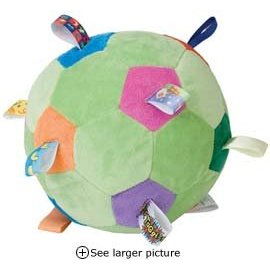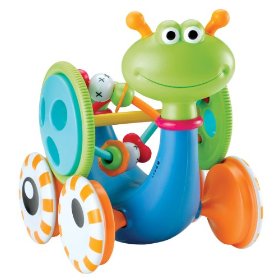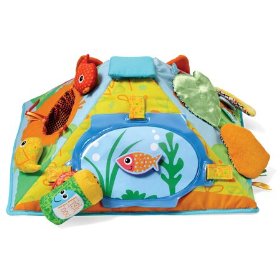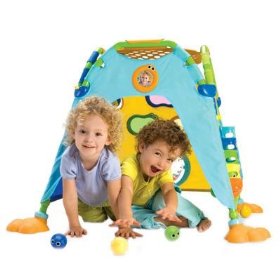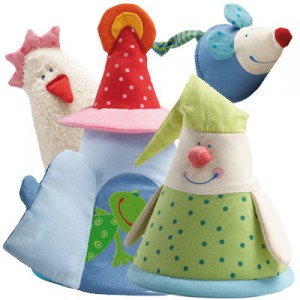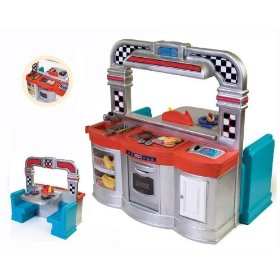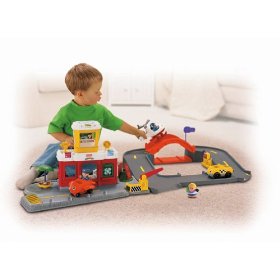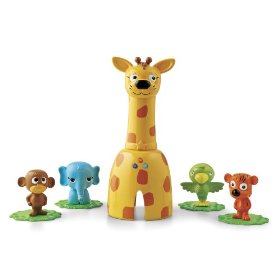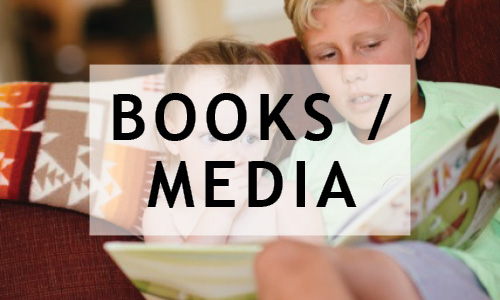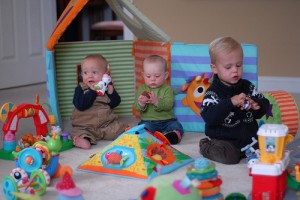 I wanted to share my lists of best toys that I began in 2008. For 2008 and 2009 I compiled my list of the best language building toys and launched the PAL Award in 2010 to carry on that tradition. So here is my first list of great toys for kids:
I wanted to share my lists of best toys that I began in 2008. For 2008 and 2009 I compiled my list of the best language building toys and launched the PAL Award in 2010 to carry on that tradition. So here is my first list of great toys for kids:
Now that all the lists are out–Parents Magazine, Parenting, Toywishes, Amazon and others–for the best new toys for holiday giving, parents are asking what to buy? All these lists are helpful but what I have assembled is a list of my favorite toys, many new but some old favorites, based on their value in building speech and language skills. I’ve added tips to build language to increase the educational value of the toy.
So “Here are a Few of My Favorite Things from 2008:”
Birth-1 years and up”
eebee’s Adventure Play Mat and Play House (6 months to 3 years): Every now and then a toy comes along that I get really excited about. This is one. Maybe because I had an older brother and he was always making forts out of our couch cushions and planting me inside with a bowl of popcorn! This colorful set of foam sections, attachable with Velcro strips, invites your child to make a house and climb right in. Every day he can make a new creation, lift the curtain to peek out the window, catch a glimpse in the mirror, crawl through the circular hole or have a chat with a eebee’s life size face. crawling babies enjoy exploring the vibrant, textured panels even when they are laid out flat.
Language Building Tips: Follow you child’s interest and describe the colors, textures, and features of the panels. Use action verbs to name what your child is doing such as going “in” “out” or “through.” Provide a few additional props for an older toddler such as play dishes for a picnic or tea party.
Taggie First Touch Ball (6 months and up): This newest member of the Taggies family is a soft, cuddly, grabbable soccer ball with the smooth tags that attract kids. Great for rolling, retrieving, and jamming in the mouth, this ball inspires new crawlers to take off.
Language Building Tips: Place the ball a little out of reach and talk to your child about trying to get it as they reach and lean into it. Describe the little pictures and designs on the taggies before they are popped in her mouth.
Yookidoo Swap and Go Snail (6 months and up): Press his tail and this swirling snail with the goofy grin sets off across the floor.l Babies and toddlers are mesmerized before following this leader. With two options for rotating action, either place the swirling beads or stacking toy on the snail’s back. Each is a toy in itself as babies teethe on the rings and toddlers place them on the peekaboo face of the stacking totem.
Language Building Tips: Describe the snail’s action, “circles and balls rotating on the wheels, white x-balls and nubby pink ones sliding down the shafts” etc. Don’t be afraid to use adult words. This builds a child’s vocabulary. Talk about what your child is looking at whether it is a black and white striped ring or the three pronged green tail.
Infantino Playtime Activity Center (6 months and up): This pyramid of fun has four flat sides of entertainment,–a mirror in the cat’s face, bugs to discover under textured flaps, and a jingle fish to swat in his fishbowl and two birds to settle in their nest. It’s angled just right for tummy time or a visit from a sitting or crawling baby. Parents love the portability as you release the velcro and open up a side, fold if flat and stash it in your diaper bag. Here’s a candidate for a plane trip or visit to Grandma’s.
Language Building Tips: Describe the action using nouns and verbs like putting the birds in and out of the nest, swinging the fish in his fishbowl, dropping toys down the center, peeking in the mirror or looking at the bugs. Talk about textures while comparing slippery, round and smooth, give names to the sounds of jingle and crinkle and point out colors and patterns.
Discovery Playhouse by Yookidoo (12 months and up): This kid’s hut made Parents and Parenting Magazine’s list of top toys for the year. Sturdy, yet easily collapsible, it provides fun inside and out. With kid-sized openings for coming and going, and shape sorting, spinning and ball play on the exterior, kids are entertained on all sides.
Language Building Tips: As with any fort, leave the imagination and creativity up to your child and his buddies. You can set some extra props outside the hut for their use: dishes, flashlight, pretend tools or food to be available for your child to expand his play. Remember to let him be the leader of his play.
Activity Stacker by Infantino (6 months and up): Babies sit down for a munch on a variety of textured rings, each with a little different flavor of color, texture, pattern, and sound. Favorites are the ring with a little chick sliding along, a fish that rattles beads, and the shiny, crinkle, multi-pedaled flower. Each ring is easy to slip onto the base, which provides fun in its own right as a soft mallet to bang for a squeak.
Language Building Tips: Babies in the oral stage usually choose one ring at a time to explore in their mouth so you have the opportunity to describe all its features. Talk about chicks and fish, giving a few more details about them–where they live, what they do. Any new words you use to describe what she is doing, build her vocabulary.
Stacking Quartet by Haba (6 months to 3 years): An entertaining gang of a clown, mouse, and fuzzy
chicken provide teething delight to a baby, especially the tall jester hat on the clown, play peek-a-boo as they nest together inside one another, fitting into their house, and serve as puppets for creative play for preschoolers. Haba’s characters are deliciously charming to both kids and adults.
Language Building Tips: Put an animal on your hand and start a conversation with another. Model a fun chat back and forth, making up a story about the characters, as if reading a book.
Preschool:
Dino Valley by Lego (3-6 years): Combine the creative, High quality brand of Lefo with a kid’s fascination with dinosaurs and you have a winner. 52 pieces easily slip together to form the valley of adventure as cavemen and dinosaurs co-exist. The tree, vine and drawbridge provide escapes and hiding places while a canoe, fishing pole and fish set the stage for storytelling. Visit the Lego website under Duplo for other great sets not typically seen at toy stores. I also like the “In and Around the Town” series like the farm and constructions sets.
Tips for Building Language: Take a dinosaur or caveman and start the dialogue with your child, alternating as he picks a figure to converse with you. You are building conversationally skills while your child is using his imagination and making up the story. Let him guide the story and follow his lead.
Step2 50’s Diner (2-7 years): This retro diner takes a kid’s kitchen one step further, providing attached seating and a pass through opening to place and get your order. Children can role-play, tkae a turn as chef
or customer. Take a seat in the booth, order your lunch and watch the chef prepare it on the grill, stove or in the oven. Pass the time listening to the jukebox until the “order is ready” button sounds. With a coffee pot, ice cream scoops and plenty of pretend food, this diner feed the imagination in any child. It will lead to many happy days!
Tips for Building Language: Stand back and watch your child build a story as she uses her imagination. After a while, point out different features or directions for play but only suggest, don’t lead. Add some new props such as a timer, measuring cups or dish towels to expand play.
Fisher Price Little People Airport (2 to 5 Years): This toy was a favorite when I taught preschool several years ago and had just the same intrigue when I gave it to 2 year-old Will this week for an early Christmas gift. Combining air and land vehicles, what could be more fun for a boy? Several open-ended venues invite a child to use his imagination and make up variations on his play scheme–a picnic area, luggage claim, taxi, airplane and helicopter, gates to enter, air traffic control and plenty of highway to get to and from the airport.
Tips for Building Language: Bring play-doh to the airport and form food, carry ons, tickets etc that relate to the theme. Let your child’s imagination take off. See my article on using play-doh to extend play.
Circo Kid’s Frog Play Tent from Target (3 and up): Enter through the frog’s wide mouth, step across his orange tongue and you can zip yourself in to this hideaway. Easy to assemble, this fort is most like a tent with four collapsible tubes to support the frog. It breaks down to fit into a compact carrying bag. Big enough to hold some friends, it measures 35″ high and 71″ in diameter. The price is right at around $20.
Animal Scramble by Wild Planet (3 to 5 years): Want to run off some of that youthful energy? This preschool versions of Hyper Dash(an equally great game for older kids) keeps your children moving,
listening and following directions. With 5 levels of play ahnd 4 options to play alone, with a group, go on a treasure hunt or use your memory, this scramble will deep everyone’s interest. Listen for the giraffe to call out a clue using colors, numbers and animal sounds like “Which animal is green?” and tag it with the giraffe. This smart giraffe keeps track of your time so every dash turn into a race.
Games for ages 4 and up:
Pengoloo by Blue Orange (4 and up): Waddle on down to the South Pole and start gathering these adorable penguins for a hot game of Pengoloo.Kids love the element of surprise as they roll the two-colored dice and peek under two penguins per turn to reveal their brightly colored eggs. Get a match and declare they’re yours, placing them in order, 1-6, on your patch of ice. Keep it simple for a 4 year-old or step up the strategy and “steal” a penguin from your opponent’s iceberg to make your match. Blue Orange’s signature bright, bold graphics and tactiley pleasing wooden pieces attract kids and adults immediately. A full iceberg declares a winner who has reinforced color and number concepts and built visual memory skills.
Animal Soup by Briarpatch (5 and up): Kids beg to play Animal Soup again and again. Every player gets a flip book with variations on their cartoon-style animal. Each picture varies with the addition of a scarf, tiara, jeweled necklace, lei, or varied hats. It’s a race to be the first one to match your picture to the figures on the game board so the winner can collect an animal disc out of the soup bowl. Kids love this game, not realizing that while they’re madly looking for their animal match, they are building their visual discrimination, memory, and fine motor skills.
Clothespins! by Briarpatch (5 and up): This game of strategy requires the player to collect items of clothing by pattern—polka dots, stripes or wiggly lines, or by type—pants, tops or shorts. Finish three laundry lines with three matching articles of clothing and you win. But don’t let the bird steal your laundry! It’s a kid’s version of Gin Rummy!
Chocolate Fix by ThinkFun Inc (8 and up): This gold award winner from Parents Choice is a feast of fun! Take turns filling your customer’s orders at the chocolate shoppe. Flip to the page of visual clues on where to put your 9 tempting treats in three flavors and three shapes. Let’s see, the pink square chocolate is next to the dark circle chocolate. In the grid of nine positions, the chocolatier has to solve all the clues to place the pieces in just the right spot. With several levels of play, kids and adults are entertained. An added language building value is that kids love to role-play as the chocolatier and the customer!
Pirates Undercover by (5 and up): Pirates Undercover is a puzzle lover’s delight! Kids from 5 and up are challenged to use the 4 puzzle pieces to hide the pirate ships, rowboats, islands, and treasure and only reveal what is pictured on each page of the challenge book. The book provides 48 pages of images that must be left uncovered to master that challenge–from “starter” to “expert” to “master.” Parents want games they can play as a family and this is one of them. It can even be played alone, as a challenging puzzle requiring strategy and logic.
